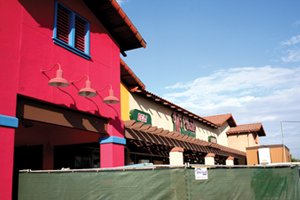A motion to appeal Mi Pueblo’s bright facade was denied, but not
before the City Council added their own color to the saga.
What began as a practical discussion about the Gilroy Planning
Commission focusing more on the economic benefits of Mi Pueblo,
instead of following city code, soon became an animated debate
about colorblind officials.
Gilroy
A motion to appeal Mi Pueblo’s bright facade was denied, but not before the City Council added their own color to the saga.
The Hispanic foods chain has already stirred debate of what is tacky as compared to corporate identity and the importance of financial gain as compared to city regulation.
The issue of whether the bright-colored grocery store fit in with the all-beige businesses on the 700 block of First Street in Gilroy, took a new twist.
What began as a practical discussion about the Gilroy Planning Commission focusing more on the economic benefits of Mi Pueblo, instead of following city code, soon became an animated debate about colorblind officials.
At issue was Planning Commissioner Ben Anderson’s participation in the Commission’s Oct. 7 decision to allow Mi Pueblo to keep its color scheme, since he admitted he was colorblind.
How can a colorblind commissioner make a decision on colors?
“(The Planning Commission meeting) was very concerning. The commissioners were all over the place,” said Councilman Dion Bracco, who watched the televised meeting.
“One commissioner stated that he was colorblind, and neither the chair nor the planning director gave these folks any direction. When he said he was colorblind, they should have said he should refute himself,” Bracco said.
The issue was dropped for a few minutes as the Council prepared to vote on the item introduced by Mayor Al Pinheiro.
During the 5-1 decision where Pinheiro was the only dissenting vote, Councilman Perry Woodward decided to abstain. Delayed by traffic, he had taken a seat at the dais when discussion on the item was well under way. Woodward said he wouldn’t vote, because he is also colorblind.
Councilman Peter Arellano, a physician, was quick to refute Woodward’s position.
“I think we can have legally blind councilpersons who can still make a decision on the ordinance and on what is compatible in terms of color,” he said.
“I’m colorblind and you want me to decide on the colors of the store, Dr. Arrellano?” responded Woodward drawing a few soft chuckles from the public.
Colorblindness was just one shade of the City Council debate.
Some in the Council also questioned the vagueness of the city code.
Mi Pueblo appealed the Gilroy Planning Department’s decision which pointed to City Zoning Ordinance Section 50.44. The ordinance states any building planned must be harmonious with the adjacent development. The result was a 5-2 decision, with the Commission adding a requirement that the grocery store work with planning department staff and local businesses to come to a more acceptable color scheme.
Anderson was key in breaking an impasse at the meeting. He suggested the applicant drop some of its cranberry paint, and did not delve into the economic benefits of the store.
Commissioners did mention muting the colors would affect Mi Pueblo’s corporate branding at the Oct. 7 meeting.
Chair Jim Gailey asked commissioners to consider whether the city was asking too much from the foods store.
“I think what they’re asking is little in relation to what they’re providing to us,” said Gailey, referring to the jobs Mi Pueblo would create.
The San Jose-based Hispanic foods chain has 17 locations throughout Northern California with $2.8 million invested in the Gilroy store.
Pinheiro said the Planning Commission focused too much on the economic benefits of the grocery store which is slated to open Nov. 6
This prompted discussion on whether the city code is narrowly tailored.
“The problem lies with your code, and I don’t believe you should take it out on the Planning Commission,” said Richard Spitler, president and chief executive officer of the Gilroy Economic Development Corporation.
Spitler spoke during the public comment portion stressing the Commission took the proper stance.
“They did deliberate this. In fact you’ll have as hard a decision as they did because it’s subjective.”
Councilman Craig Gartman asked if the City Council would be better suited to decide whether the code was vague.
“We need to define if the decision is to appeal or change the code, or if it is an issue of color,” Gartman said. “Because if it’s a process issue, we should be working with the Planning Department. The vice chair (Anderson) and I joked he was colorblind, but that doesn’t stop him from understanding the differences between colors.”
Gartman said the Council was singling out Mi Pueblo’s case as an example of a vague code rather than tackling the code itself and said he would not back Pinheiro in his appeal.
“(The appeal request) made me open my eyes a little bit more. And seeing the bright colors of other buildings, I think we have some inconsistencies within the city code,” he said. “We will allow their colors but we won’t allow other colors. To use this organization as an example is unfair to anyone.”
Pinheiro responded he did not intend to single out Mi Pueblo, but did not want to let business interests cloud the city’s judgment.
“This is not at all what the mayor is trying to do,” he said. “I worked with (the applicant) from day one, but it’s the choice of this city as to what goes on in the city.”
By the time the Pinheiro opened the floor for public comment, a few councilmembers had already said they would vote against the appeal.
“You’ve already heard how the Council made up their mind before listening to you,” said Pinheiro. “Let that not deter you from coming up to speak.”














